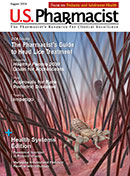In a publication in Digestive Diseases and Sciences, researchers conducted a cross-sectional study involving older patients with inflammatory bowel disease (IBD) to characterize the impact of polypharmacy on this patient population.
The study population included 100 adults aged ≥60 years (median age 68 years) who had IBD. The researchers used information from medical records and patients to gather a medication list and evaluate medications based on Beer’s criteria, anticholinergic burden, and drug-drug interactions.
To evaluate the correlation between polypharmacy and low quality of life (QoL), the researchers constructed multivariate logistic regression models, controlling for age, gender, IBD type, number of comorbidities, and depression.
Fifty-six percent of the study cohort met the criteria for remission by a validated disease activity index.
The researchers defined polypharmacy as ≥5 concomitant medications. Severe polypharmacy was defined as ≥10 concomitant medications. Data revealed that 86% and 45% of the patient population met the criteria for polypharmacy and severe polypharmacy, respectively.
Additionally, within the study cohort, 48% of patients were on ≥1 medication that met Beer’s criteria for potentially inappropriate use in older adults, and 25% were taking ≥2 potentially inappropriate medications.
The most frequently recorded medications in this cohort that met the Beer’s criteria included antispasmodic agents, tricyclic antidepressants, and benzodiazepines.
Twenty-four percent of the cohort had a cumulative anticholinergic drug burden score of ≥3, which was as the threshold for serious adverse events attributed to anticholinergic burden.
The principal medications reported in this category included beta-blockers (18%) and antidepressants (17%). The results also revealed that serious drug-drug interactions occurred in 26% of the cohort, with 7% of these interactions involving an IBD medication.
The researchers noted that study participants who had severe polypharmacy were more prone to screen positive for mild cognitive impairment compared with those without severe polypharmacy (36% vs. 16%; P =.03).
The researchers added, “Older adults taking at least 5 medications vs fewer than 5 had nearly a 23 times greater likelihood of having lower QoL (odds ratio [OR], 22.79; P <.01). Older adults with IBD who were taking at least one medication listed as potentially inappropriate for older adults by the Beers criteria had nearly 2 times greater odds of having a low quality of life than those not taking any potentially appropriate medications (P <.01).”
Based on their findings, the researchers concluded that polypharmacy is widespread in older adults with IBD and is independently correlated with low QoL. They also wrote, “We found a strong, independent association between polypharmacy, numeric as well as those that are potentially inappropriate for older adults, and low quality of life.”
The researchers added, “Understanding aspects of IBD and its symptoms that are contributing to polypharmacy in older adults with IBD may be beneficial to improving quality of life in older adults with IBD.”
The content contained in this article is for informational purposes only. The content is not intended to be a substitute for professional advice. Reliance on any information provided in this article is solely at your own risk.





